Phylum porifera - Study guides, Class notes & Summaries
Looking for the best study guides, study notes and summaries about Phylum porifera? On this page you'll find 131 study documents about Phylum porifera.
Page 4 out of 131 results
Sort by
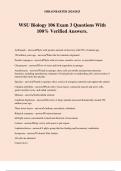
-
WSU Biology 106 Exam 3 Questions With 100% Verified Answers.
- Exam (elaborations) • 14 pages • 2024
- Available in package deal
-
- $10.49
- + learn more
WSU Biology 106 Exam 3 Questions With 100% Verified Answers. Arthropods - answerPhyla with greatest amount of diversity with 85% of animal spp 700 million years ago - answerWhen the first animals originated Porifera (sponges) - answerPhyla with no tissues, muscles, nerves, or specialized organs Choanocytes - answerFlow of water and food acquisition in sponges Amoebocytes - answerFound in sponges, these cells are mobile and perform numerous functions, including reproduction, transport of f...

-
Biology 1108 Exam 3 Questions and Answers Latest Update | 120 Questions | Graded A+
- Exam (elaborations) • 21 pages • 2023
-
- $16.49
- + learn more
Biology 1108 Exam 3 Questions and Answers (Latest Update) 120 Questions | Graded A+. Alpine - Correct Answers Similar to Tundra, Lacks permafrost, Budding - Correct Answers Form of asexual reproduction in which a bud/protrusion forms on an organism and eventually breaks off to form a new organism that is smaller than its parent. Fragmentation - Correct Answers A type of asexual reproduction in which one organism is broken into pieces, each of which develops into a new individual Partheno...
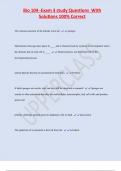
-
Bio 104 -Exam 3 study Questions With Solutions 100% Correct
- Exam (elaborations) • 11 pages • 2024
-
- $14.49
- + learn more
Bio 104 -Exam 3 study Questions With Solutions 100% Correct The common ancestor of all animals is/are the: sponges Determinate cleavage takes place in ____ and is characterized by a pattern of development where the ultimate fate of each cell is ____. Deuterostomes; not fixed until late in the developmental process animal phylum that has an asymmetrical body plan. Porifera If adult sponges are sessile, why can they still be classified as animals? Sponges are similar to other animals i...
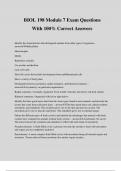
-
BIOL 198 Module 7 Exam Questions With 100% Correct Answers
- Exam (elaborations) • 18 pages • 2024
- Available in package deal
-
- $12.49
- + learn more
BIOL 198 Module 7 Exam Questions With 100% Correct Answers Identify the characteristics that distinguish animals from other types of organisms. - answerMulticellular Heterotrophic Motile Reproduce sexually Use aerobic metabolism Lack cell walls Have life cycles that include development from undifferentiated cells Have a variety of body plans Distinguish between asymmetry, radial symmetry, and bilateral symmetry. - answerAsymmetry: no particular organization Radial symmetry: Circular...
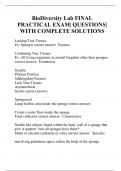
-
BioDiversity Lab FINAL PRACTICAL EXAM| QUESTIONS| WITH COMPLETE SOLUTIONS
- Exam (elaborations) • 31 pages • 2023
-
- $13.99
- + learn more
Lacking True Tissues Ex: Sponges correct answer: Parazoa Containing True Tissues Ex: All living organisms in animal kingdom other than sponges. correct answer: Eumatazoa Scypha Phylum Porifera Subkingdom Parazoa Lack True Tissues Asymmetrical Sessile correct answer: Spongocoel Large hollow area inside the sponge correct answer: Create a water flow inside the sponge Food collectors correct answer: Choanocytes Needle like objects found within the body wall of a spong...
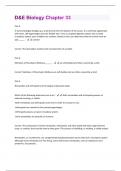
-
D&E Biology Chapter 33 Questions And Answers With Verified Solutions Graded A+
- Exam (elaborations) • 6 pages • 2024
-
- $7.99
- + learn more
Part A A marine biologist dredges up a small animal from the bottom of the ocean. It is uniformly segmented, with short, stiff appendages and soft, flexible skin. It has a complete digestive system and a closed circulatory system, plus multiple true coeloms. Based on this, you determine that the animal must be a(n) _____. - annelid Correct: The description matches the characteristics of annelids. Part A Members of the phylum Mollusca _____. - are soft-bodied and often covered by a shell ...

-
BIOL 198 Module 7 Exam Questions With 100% Correct Answers
- Exam (elaborations) • 18 pages • 2024
-
- $12.49
- + learn more
BIOL 198 Module 7 Exam Questions With 100% Correct Answers Identify the characteristics that distinguish animals from other types of organisms. - answerMulticellular Heterotrophic Motile Reproduce sexually Use aerobic metabolism Lack cell walls Have life cycles that include development from undifferentiated cells Have a variety of body plans Distinguish between asymmetry, radial symmetry, and bilateral symmetry. - answerAsymmetry: no particular organization Radial symmetry: Circular...
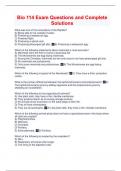
-
Bio 114 Exam Questions and Complete Solutions
- Exam (elaborations) • 8 pages • 2024
- Available in package deal
-
- $8.99
- + learn more
What was one of the innovations of the Reptilia? A) Being able to live outside of water. B) Producing a waterproof egg. C) Powered flight. D) Producing a spinal cord. E) Producing pharyngeal gill slits. B) Producing a waterproof egg. Which of the following statements about mammals is most accurate? A) Mammals were the first to evolve a post-anal tail. B) The Monotremes are egg-laying mammals. C) Among the Chordata, mammals are the only ones to not have pharyngeal gill slits. D) All mammals are ...

-
WSU Biology 106 Exam 3 QUESTIONS AND CORRECT DETAILED ANSWERS WITH RATIONALES |ALREADY GRADED A+
- Exam (elaborations) • 14 pages • 2023
- Available in package deal
-
- $13.99
- + learn more
WSU Biology 106 Exam 3 QUESTIONS AND CORRECT DETAILED ANSWERS WITH RATIONALES |ALREADY GRADED A+ Arthropods - ANSWER- Phyla with greatest amount of diversity with 85% of animal spp 700 million years ago - ANSWER- When the first animals originated Porifera (sponges) - ANSWER- Phyla with no tissues, muscles, nerves, or specialized organs Choanocytes - ANSWER- Flow of water and food acquisition in sponges Amoebocytes - ANSWER- Found in sponges, these cells are mobile and perform numer...
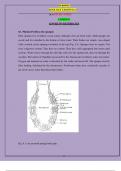
-
NURSING ZOOLOGY LESSON 8-13 (A+) STUDY NOTE
- Class notes • 51 pages • 2023
-
- $15.49
- + learn more
8.1. Phylum Porifera (the sponges) Most sponges live in shallow ocean waters, although a few are fresh water. Adult sponges are sessile and live attached to the bottom of clear water. Their bodies are simple, vase-shaped with a central cavity opening (osculum) at the top (Fig. 9.1). Sponges have no organs. Not even a digestive system. They have no coelom. They have cells aggregated into water canal systems. Water moves through the tube-like cells into the spongocoel, then out through the o...

Study stress? For sellers on Stuvia, these are actually golden times. KA-CHING! Earn from your study resources too and start uploading now. Discover all about earning on Stuvia


